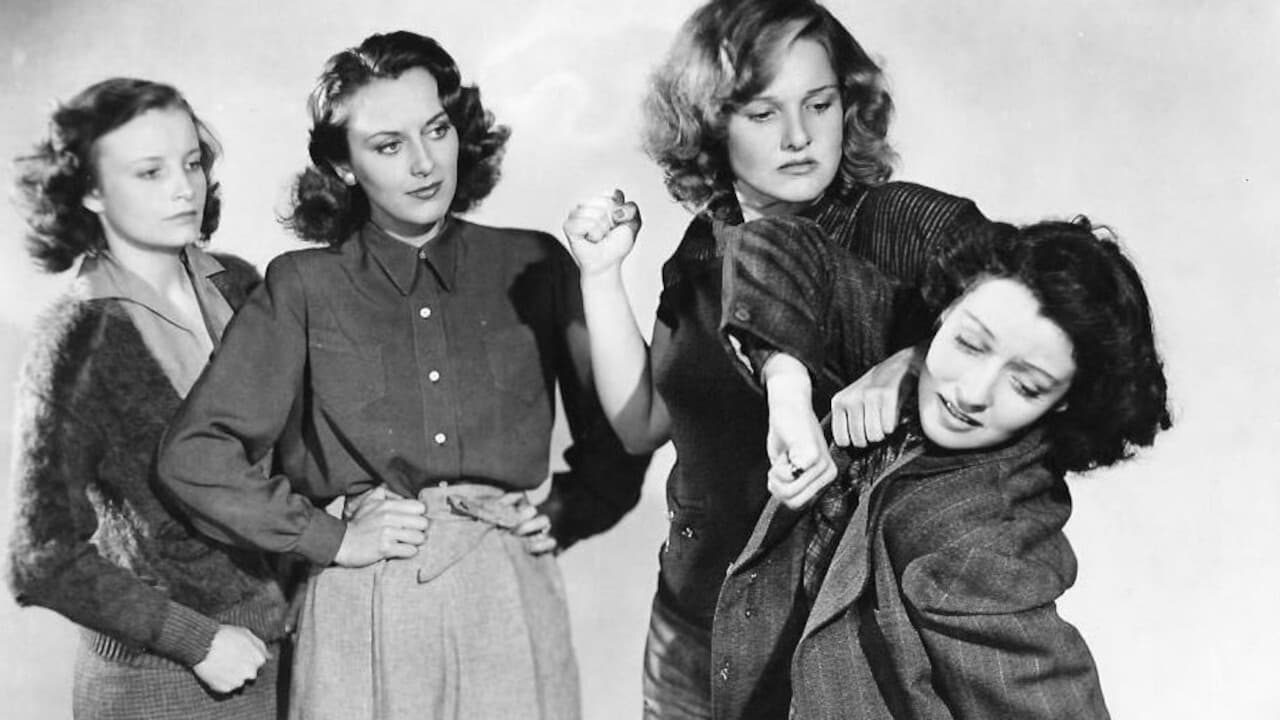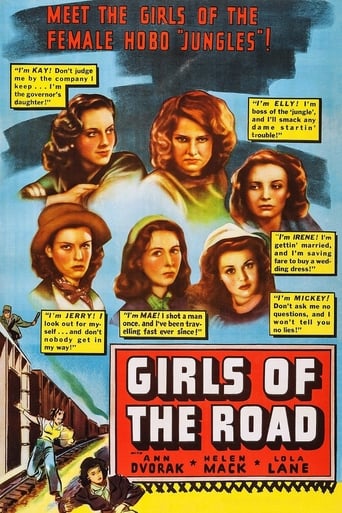

Better Late Then Never
... View MoreAdmirable film.
... View Moreit is the rare 'crazy' movie that actually has something to say.
... View MoreA great movie, one of the best of this year. There was a bit of confusion at one point in the plot, but nothing serious.
... View MoreA governor's daughter (Ann Dvorak) is concerned about girls living on the road with no family, no jobs and no money. She becomes one and, almost instantly, becomes friends with a hardened "road girl" named Mickey (Helen Mack). We then see a (purpotedly) truthful version of what girls on their own have to do to survive.No budget Columbia picture. In 1940 this might have been a little shocking but today it comes across as silly and not even remotely truthful. Supposedly all these girls have lived on the road without clean clothes, showers or food for days--but they all look well fed, they're in clean clothes and are pretty healthy with makeup and beautiful hair. Even their hideout looks pretty opulent! Also when this film strives to make a message it's so overdone it comes off as comical. The funeral of one of the girls is supposed to be tragic but it comes off as unintentionally funny! Still, it's well done and Mack gives a good performance. It's marginally worth seeing if you're into obscure older movies (like me). I give it a 5.
... View MoreIn many ways, this film reminds me of the 1933 film "Wild Boys of the Road"--which is about homeless teens who wander about the country (often in vain) looking for work and a square meal. This film is about homeless ladies who are in similar circumstances. How serious this problem was is uncertain (it's not like they kept statistics on this), but the movie seems earnest--and amazingly naive.The film begins with a commission reporting to the Governor about the plight of wandering homeless ladies. The Governor is moved and wants to do something but is uncertain if anything can be done about the problem. However, his secretary (Ann Dvorak--who also happens to be his daughter in the film) decides to investigate herself by hitting the road and posing as a homeless woman. This is an insanely naive and rather offensive notion--especially when she could be raped or otherwise exploited and the idea of a rich girl "slumming it" is a tad silly. In fact, in one of the first scenes, this nearly happens (in a sanitized 1940 manner) as a man isn't about to take 'no' for an answer after he picks up Ann.Ultimately, after spending time getting arrested for vagrancy, being hassled by cops, jumping trains, getting robbed and the rest in this 'dog eat dog world', Ann returns home to report to Daddy about the life of girl hobos. My quote in the summary, while not exactly what she said isn't that far from it! And, naturally, it all had a happy ending.To me, this film seemed rather fake. All the ladies looked really ragged...like they'd forgotten to put on the morning makeup and had gone a whole week without going to the beauty parlor! The most egregious of these was Dvorak--who looked like she was dressed for publicity photos of "her life when she has a day off". The ladies' "down and out" looks just seemed like Hollywood's sanitized version of the life of a homeless woman--the type that wouldn't feel particularly threatening to most in the audience. Compare this sort of film with a REAL film about social ills of the 1930s (such as "I Was A Fugitive From A Chain Gang") and this one comes up wanting. Perhaps well-intentioned and the acting wasn't bad, but it was fake from start to finish.
... View MoreThe best thing about this highly sanitized expose is that its heart is in the right place. Importantly, the movie serves as a peek into how the uprooted, even women, were treated by local jurisdictions already burdened by their own Depression problems and unwilling to take on new ones. However, the contrast with the gritty, realistic Wild Boys of the Road (1933) could hardly be stronger, thanks mainly to the deadening hand of the Production Code of 1934. Note, for example, the general absence of men around these all-girl encampments, rather surprising given the opportunities. But then, including men in the camp mix would have complicated both the tone and the message. Thus, we're left with what looks like an all-girl touring group down on their luck. Note too, how nearly all the well-scrubbed girls are outfitted in the less vulnerable pants instead of dresses at a time when cheap cotton dresses were standard and affordable, (consider Barbara Hershey's cheap little print in the much more realistic Boxcar Bertha {1972}). But most revealing is when one of the girls explains why it's easier being a penniless man than a penniless woman. What she says is true, but, tellingly, she leaves out the one big advantage women-- especially the comely young women of this movie-- have when needing to earn a buck. In fact, as part of its streamlining and sanitizing, the screenplay suppresses altogether what should be the rather obvious topic of prostitution.All in all, I suspect the movie reveals more about the state of Hollywood politics, circa 1940, than it does about its subject matter. Nonetheless, I agree that TMC should be congratulated for reviving such obscurities. And though the movie is, I think, far from a classic, it is a provocative window into its time and into a topic many of us didn't know existed. Besides, I sense an underground fan club forming around the sorely neglected Ann Dvorak. With her large, expressive eyes, aquiline nose, and the courage to take on an ethnic stage name-- plus genuine talent-- she merits re-discovery in a big way.
... View MoreOnce again, Turner Classic Movies has rescued another rough-cut gem from obscurity in the musty vaults of Hollywood! TCM has changed my life by showing the classics that most of us never even knew existed. And "Girls of the Road" is definitely in that category.Okay, so it's not "Gone With the Wind," but it's a classic even so. I've never seen anything quite like it. It's about female hobos from the Depression, running from the cops, fighting each other, living the vida loca al camino! Only in this subculture, all the women are young, beautiful and "good on the inside." Closest thing to this story I've seen is the "women in prison" movie genre of the period. There's a social-reform angle to it, as there was in many of the women in prison films. Remember, this was 1940--the Production Code ruled Hollywood. It was not possible to depict any vagrants or criminals in a positive light, at least not until they received a moral makeover.Watch it for entertainment, though, not for any particular message. Such as it was, the message was about as substantive as a mouthful of cotton candy. The stars had some funny lines, almost all were good looking, and life didn't look so bad at the end. What more can you ask for?
... View More